Podcast 281: Cooling Hot Roofs, Material Shortages, and Blower Doors
Colin, Matt and Patrick hear from listeners about the durability of building tapes and doing without PT lumber, before taking questions on venting roofs in hot places, finding contractors in Covid times, and absent airtightness tests.
Follow the Fine Homebuilding Podcast on your favorite app. Subscribe now and don’t miss an episode:
 |
 |
Help us make better episodes and enter for a chance to win an FHB Podcast T-shirt:
www.finehomebuilding.com/podcastsurvey
Longtime friend Dyami weighs in on the durability of building tapes. Ed suggests Penetreat as a PT alternative. Dr. Adam reminds listeners to be safe. Paul from Texas says roof venting is about more than ice-damming. Carson asks if Covid has changed construction forever. Ryan wants to know why his energy audit was missing a blower door test and John asks about blower doors for the rest of us.
Editor Updates:
- Colin’s gravel yard
- Matt’s hot compost
- Jeff’s welding
- Patrick’s generator and oil
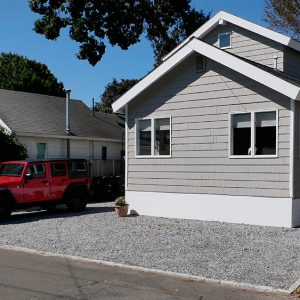 |
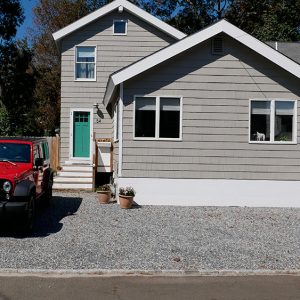 |
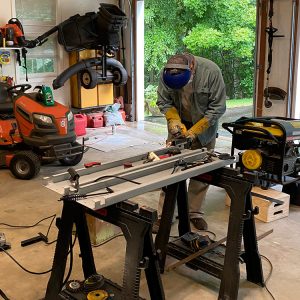 |
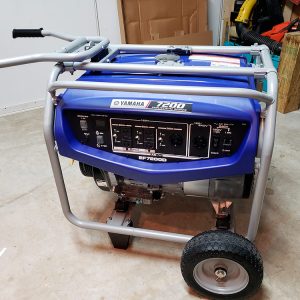 |
Listener Feedback 1:
Dyami writes: FHB Crew, Hello and happy air sealing. I was listening to the July 10th episode which ended with a very brief discussion of tapes and sealants and how they would likely be the most-likely point of failure as modern houses aged. well I’ll be the first to admit that the change in available tapes and sealants is the most dynamic of any modern building component, I am of two minds regarding their lifespan. regarding most sealants I believe they will fail this is been proven to us time and time again in the field as we’ve used a variety of roof sealants. well there are a few which have proven the test of time and I’ve seen perform for well over 20 years most fail within a matter of months. Regarding tapes, my experience has been the exact opposite almost every tape product we have used seems to last a very long time. In the mid-1990s typical seam sealant was replaced with seam tape. where I could tell the age of a roof simply by looking at the condition of the sealant on the seams, and that sealant never lasted beyond 10 to 15 years, I don’t know how long the tape will last because the tape switch were installed in the mid-90s are still performing as they were designed to and have yet to fail because of age. while you understand that 25 years is not what we’re aiming a house to last the tapes you use in flat roofing are subject to the extreme temperature Delta’s and snow and ice that most building components don’t have their also exposed to dramatically more UV than most building components. as these roofing tapes last so long and perform so well I’m relatively confident that he has a similar product that is protected from thermal shock and UV exposure and most direct moisture contact will last as long as it is intended to.
Please keep up the great discussion.
Related Links:
Listener Feedback 2:
Christopher writes: Patrick and team, In Podcast 275: Making Do Without PT, Wasting Paint, and Staging High Work you discussed alternatives to PT, including using wood preservatives, painting, and using rot resistant wood species.
I have had excellent results using Douglas Fir that I soaked with Penetreat, a borate product that has very low toxicity for humans, and very high toxicity for wood boring insects and fungi.
To keep the borate from diffusing out of the wood, use an exterior stain over the Douglas Fir.
I built a run for chickens that looked “as good as new” until the recent storm in the northeast that uprooted a tree which absolutely crushed our chicken coop and run. So, unfortunately, the borate does not preserve structures from falling trees!!!
As suggested in the podcast, I would still look to get the shed up off the ground for best results.
Related links:
Listener Feedback 3:
Dr. Adam M.D. writes: Good Afternoon; I’ve been listening to your podcast for quite a while and its not only excellent in its current iteration, but it keeps getting better. I thoroughly enjoy it and thank all of you for the hard work you put into it.
To follow up the occasional discussion you have about safety every once and a while; and the excellent article about lines and safety on roofs. I can say it is incredibly important! I’ve worked in ERs for over 10years now and I can say work place related injuries show up frequently. It has ended the career of many people that I have seen and rarely seen a fatality due to work related issues. The sheer volume of fingers I’ve seen missing from table saws is staggering. On that note, snow blowers are also great at taking off fingers quickly.
Please wear goggles, gloves, get a saw stop, harnesses and keep your head up and know your surroundings. This doesn’t have to be a short career and there is good safety devices available to protect you on the job site.
Keep safe out there and keep up the great podcasts!
Related links:
Question 1: Are roof vents in hot climates for removing moisture or heat?
A listener writes, It’s interesting to hear the conversation about venting with regard to ice damming and moisture control. I lived most of my life in Texas, where ice damming is *never* a problem. That white stuff falling from the sky was always confusing on the rare occasion that it came – what’s this stuff? Manna from heaven?
No, in Texas the roof venting is to get rid of the heat. Imagine having the attic cavity at 140F – or more – when trying to maintain the inside temps below 80F with refrigeration.
A number of years ago I reclaimed a largish attic space to build an upstairs office in a house in San Antonio. The house was built around 1990, so had reasonably recent construction. Since it was summer, I put a sprinkler hose on the roof, and turned on the water at a rate that it would just barely drip off the eves, turning the roof into a giant “swamp cooler” – the evaporation lowered the temperature to – 95F instead of 100F. I used 1/8″ Masonite – cut slightly wider than the rafter bays, then bowed it between the rafters to create an air passage from the knee wall to above the collar ties that formed the ceiling. I then put fiberglass insulation between the HDF and the drywall. It didn’t matter if the venting assembly was airtight as the whole purpose was to provide an air channel that would use the convective chimney effect to drive air through the channel, and carry most of the heat away. Insulation doesn’t stop the heat, it only slows it down. Carrying the heat away is a better solution. It worked, too! After the room was complete, I could easily feel the difference between the “normal” bays and the one close to the end where I couldn’t get the Masonite in: air channel=cool, insulation only=warm.
This technique of course works best on roofs with greater pitch, although it would help some even with lower pitch roofs. If I was doing the same today, I’d use 1″ rigid foam instead of Masonite, and I’d probably spray foam the edges before installing the fiberglass insulation. Big box stores and lumberyards also have purpose-made channels that can be stapled to the underside of the deck.
Related links:
Question 2: Do you think the labor and material shortage is going to last for a long time?
Carson writes, Hi Patrick, I have a follow up question pertaining to my build.
There was a lot of discussion about the impact of the pandemic on construction; however, locally and from what I’ve read nationally it seems that subcontractors are getting harder than ever to get hold of, while lumber costs and shortages of materials continue to increase. Do you feel that this is simply from the resumption of stalled projects or something more permanent? Is this just the worst time possible I could have ended up with to start building a house?
Sorry to hear Justin is leaving, keep up the great content. I think there will always be a demand for professionally edited and reviewed content in a field where mistakes can cost you thousands, in whatever medium that inhabits.
Related links:
- Podcast 273: Material Shortages, Paneled Ceilings, and To Vent or Not to Vent
- Have you noticed a shortage in any of the building materials you’re using?
Question 3: Shouldn’t all energy audits include blower door testing?
A listener writes, Good day everyone. I recently had someone come out to bid doing an energy audit on our home, similar to what Rob Delaney spoke about on the ProTalk Podcast.
As the inspector was wrapping up I asked about a blower door test being done both before and after the work was completed so the improvement could be measured. Much to my surprise, I was told they would not being doing a blower door test at all. The tech on site said they wouldn’t do a test because, based on the age of the home, they could disturb asbestos by sucking it out of the walls. That sounded a little suspicious, so I contacted the estimator who wrote the bid and asked the same question: “Why no blower door testing” and the response was, I quote, “you have steam heat so we can’t do a blower door at your home. There was most likely asbestos on the steam pipes.” Mind you, our steam pipes are as clean as a whistle and there is most certainly no insulation on them.
Is this something you’ve heard before or is this just a company I shouldn’t trust to come in and air seal our home?
Related links:
Question 4: Can you build your own blower door?
A listener writes, Dear FHB Podcast, Blower doors and the ancillary equipment are expensive. I live in a place where most of the single family homes are close to or over 100 years old and in the winter I see lots of ice dams so I know there are opportunities here.
How would you make a pretty good blower door? When I heard Rob Delaney on the FHB Pro Talk podcast, he was talking about all the great things the DG100 can do So he’s talking about the Energy Conservatory’s new digital manometer
It seems to me fundamentally that this is something that can be done (pretty good) with a fan and a piece of plywood. In my town there are many odd shape doors, arches of many shapes, non standard widths (mine is 39.5 inches) which make for beautiful houses but hard to get things that fit.
How about a piece of plywood cut to fit the clients window with a bit of foam, and an attic fan? I see there are manometers are for sale on Amazon for under $200. Add in the Steve Baczek fog machine and we can generate some pretty good data.
Seems to me that getting the homes tested (at all) will open enough eyes, to drive demand for airsealing.
Related links:
End Note:
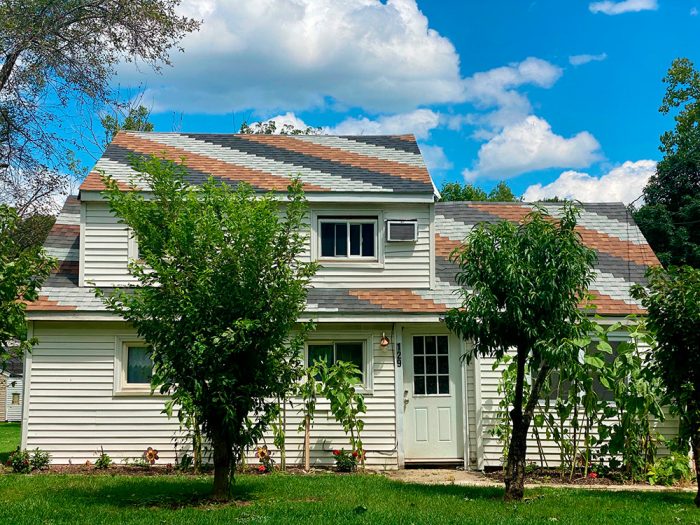 |
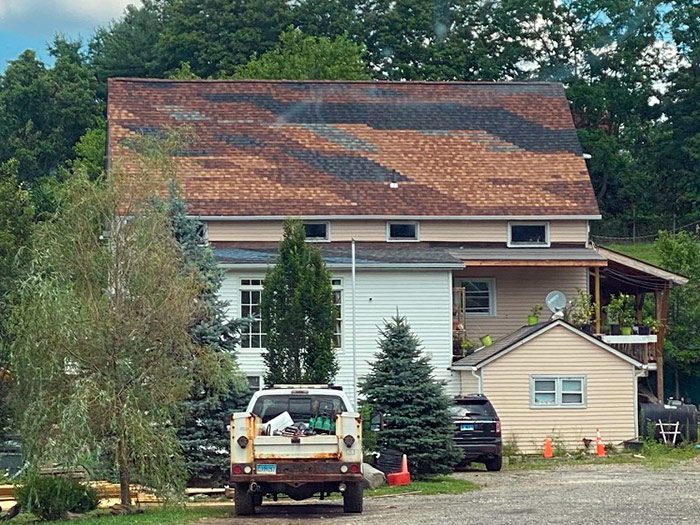 |
Kevin writes: So I got a laugh out of your last podcast. Our landscaper Max, from DeAngelo Landscaping lives around the corner on King Street in Danbury and you were talking about his rainbow color roofs on his home and outbuildings and you nailed it. He has friends in the trades and collects leftovers until he has enough to do a building.
Recently we had a new shed delivered and he took our old shed with a flatbed car hauler over to the compound to use for his miniature pony.
He’s a first generation, hard working family man, putting his son through college and hustling every day. You really kept it local for me today!
Help us make better episodes and enter for a chance to win an FHB Podcast T-shirt: www.finehomebuilding.com/podcastsurvey
If you have any questions you would like us to dig into for a future show, shoot an email our way: fhbpodcast@taunton.com.
If we use your question we’ll send you a FHB Podcast sticker!
FHB Podcast T-shirts!
Represent your favorite podcast! Available in several styles and colors. Made from 100% cotton. Find the Podcast t-shirt and more cool products in the Fine Homebuilding Store.
This episode of the Fine Homebuilding podcast is brought to you by Benjamin Obdyke.
Benjamin Obdyke would like to thank the nuisances that builders and homeowners despise. A water-resistant-barrier and rainscreen are the ideal applications to eliminate the threat of moisture from things like rain, snow, and the neighbor’s sprinkler system. Take Slicker HP, a durable Water-Resistant-Barrier attached to the Slicker Rainscreen system. This all-in-one housewrap and rainscreen won’t just protect your wall assembly, but your time and wallet, as well. It’s not rocket science… It’s building science..
Visit benjaminobdyke.com for more.
Fine Homebuilding podcast listeners can now get 20% off anything in the Taunton store, including the The Visual Handbook of Building and Remodeling, 4th Edition.
Use the discount code FHBPODCAST to take advantage of this special offer.
We hope you will take advantage of a great offer for our podcast listeners: A special 20% off the discounted rate to subscribe to the Fine Homebuilding print magazine. That link goes to finehomebuilding.com/podoffer.
The show is driven by our listeners, so please subscribe and rate us on iTunes or Google Play, and if you have any questions you would like us to dig into for a future show, shoot an email our way: fhbpodcast@taunton.com. Also, be sure to follow Justin Fink and Fine Homebuilding on Instagram, and “like” the magazine on Facebook. Note that you can watch the show above, or on YouTube at the Fine Homebuilding YouTube Channel.
The Fine Homebuilding Podcast embodies Fine Homebuilding magazine’s commitment to the preservation of craftsmanship and the advancement of home performance in residential construction. The show is an informal but vigorous conversation about the techniques and principles that allow listeners to master their design and building challenges.
Other related links
-
- All FHB podcast show notes: FineHomebuilding.com/podcast.
- #KeepCraftAlive T-shirts and hats support scholarships for building trades students. So order some gear at KeepCraftAlive.org.
- The direct link to the online store is here.































View Comments
Here is some good info on a home-made blower door using a squirrel cage furnace blower:
https://builditsolar.com/Projects/Conservation/BlowerDoor/BlowerDoor.htm
A manometer cost me less than $100 on eBay and an old blower in the junk bin looks like it will work fine. Getting a calibrated result may be challenging but this approach should be fine for basic diagnostics. If you really want an exact number, you could use this design during construction then lease a real blower door for a day. I found one online that can be leased for $120 / 1 day (plus S&H, I'm sure).